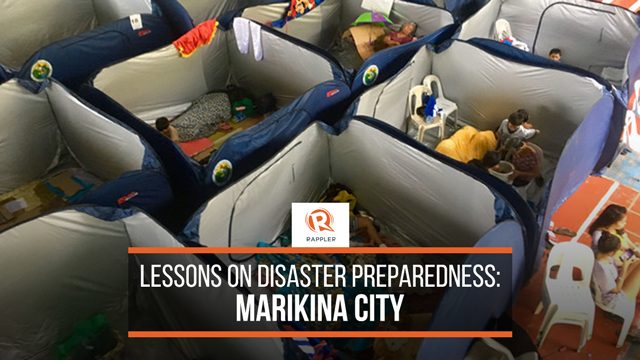SUMMARY
This is AI generated summarization, which may have errors. For context, always refer to the full article.

MANILA, Philippines – Marikina City is no stranger to disasters.
When Tropical Storm Ondoy (Ketsana) hit the country in 2009, Marikina recorded 78 deaths – the highest in Metro Manila – and millions worth of damaged properties. Since then, the city has made sure it has learned its lesson. (READ: How a hazard-prone Marikina school is preparing for disasters)
Marikina City recently wowed citizens when it prepared modular tents in evacuation centers – a far cry from the usual evacuation centers across the Philippines. (LOOK: How Marikina shelters evacuees)
‘Like a hotel’
Once evacuees reach the evacuation camp, they will have to check in and register how many of their family members have been evacuated. Just like in a hotel, Marikina City Disaster Risk Reduction and Management Office (DRRMO) Chief Dave David said they will then be given a room number for their assigned modular tent.
The data garnered from the registration in the evacuation centers will be used as basis for their next round of actions involving food preparations and other logistical requirements. Instead of providing the usual relief goods, Marikina DRRMO cooks meals for evacues to lessen the burden of the displaced families.
“With this partition tent, malaki ‘yung naging improvement namin kung paano namin i-organize si camp…. Nagkaroon ng decency ‘yung mga families na kahit displaced sila, kahit nasa evacuation centers sila, disente sila doon sa pamumuhay nila doon kasi meron silang privacy,” David said.
(With this partition tent, there’s a huge improvement as to how we organize the camp…. The families were accorded a sense of decency because even if they are displaced, they still have a decent life because they have privacy.)
The idea to use the modular tents first cropped up a year ago when Marikina City Mayor Marcelino Teodoro ordered the Marikina DRRMO to improve evacuation camps in the city. While looking for a solution, the local DRRMO stumbled upon a camp management concept from Japan. They sourced for the material, and a year later provided modular tents to Marikina evacuees.
Better evacuation centers
The modular tents became a point of comparison for other local government units. However, David clarified that provision of facilities will depend on the needs of each LGU.
“Actually nahihiya kami doon sa ibang LGU kasi we know all these LGUs have different situations sa mga cities nila and sila ang best makakaalam kung anong sistema o concept, kung anong equipment, anong resources ang puwede nilang gamitin. When we coined the idea of using the partition tent, the only purpose was to improve the situation, the living condition doon sa mga evacuation centers namin,” he said.
(Actually we’re embarrassed because we know all these LGUs have different situations in their cities and they know what system, concept, equipment or resources would be best for them. When we coined the idea of using the partition tent, the only purpose was to improve the living condition in our evacuation centers.)
According to Martin Aguda Jr, an emergency management and crowd management consultant, providing personal space and maximizing gymnasiums are already indicators that Marikina is in the right direction. Other countries, including the US, convert their sport stadiums into mega-shelters during disasters.
“Crowd management-wise doon sa (in the) evacuation area, it should not be cramped because it adds stress. Personal space is the number one [priority]. It’s very important. People would be anxious…. That can trigger some unwanted behaviors,” Aguda said.
Though using modular tents is a good practice, Aguda said that LGUs should also seek ways to create hazard-specific evacuation areas.
“It’s not enough that they build an evacuation area; they have to be really hazard-specific when they construct their designated evacuation areas,” he added.
Building a resilient community
In fostering resilience, David acknowledged that communities are just as important as government agencies in implementing disaster preparedness measures. That’s why the Marikina DRRMO prioritizes disseminating information about what to do before, during, and after the flood. It also empowers communities through training or creating community volunteering groups that would aid the DRRMO.
“’Yung level of awareness in the community is very high wherein elementary students, grades 4 to 5, would know…. Ganoon ka-aware ang community. Alam din nila saan sila tatawag, kailan sila hihingi ng tulong, kung anong gagawin nila bago pa sumampa ‘yung mataas na tubig,” David explained/
(The level of awareness in the community is very high wherein elementary students, grades 4 to 5, would know…. That’s how aware the community is. They also know where to call, when to ask for help, and what to do when the floodwaters rise.)
In Marikina, resiliency is defined as a partnership between the city government and the community. Resiliency shows when communities listen to warnings and follow instructions to evacuate when necessary.
David also urged other DRRMOs to institutionalize their flood and disaster protocols, and ensured that it would not be discontinued or swayed by political influence.
“It’s not influenced by political affiliation since disaster management is apolitical. [The] flood protocol will ensure that the operational, tactical, strategic decisions are already in place no matter who is in power,” David said.
That’s why David hopes DRRM would be institutionalized in the Philippines, especially since each DRRMO has its own best practices in dealing with disasters which could be collated for all to use.
“If we will collate all these best practices and put it into a protocol, institutionalize those best practices, then the whole nation will utilize or use the concept of these best practices,” he said. – Rappler.com
What are your local government’s best practices in dealing with disasters? Send them to MovePH!
Add a comment
How does this make you feel?
There are no comments yet. Add your comment to start the conversation.